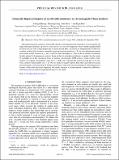Atomically dispersed tungsten on metal halide monolayer as a ferromagnetic Chern insulator
Author(s)
Huang, Chengxi; Deng, Kaiming; Zhou, Jian; Kan, Erjun
DownloadPhysRevB.98.115424.pdf (1.528Mb)
PUBLISHER_POLICY
Publisher Policy
Article is made available in accordance with the publisher's policy and may be subject to US copyright law. Please refer to the publisher's site for terms of use.
Terms of use
Metadata
Show full item recordAbstract
Although the quantum anomalous Hall (QAH) effect has been experimentally observed in several magnetically doped topological insulators, up to now, it only survives at a very low temperature. More suitable candidate QAH insulators that can work at high temperature are much desired. Here, we propose an experimentally feasible way to realize a robust QAH insulator: atomically dispersed transition metals (e.g., W) on a two-dimensional porous metal halide normal insulator (e.g., InI₃), which has been developed as a state-of-the-art chemical technology broadly adopted for homogeneous catalysis. Based on the first-principles calculations, we predict that the atomic W embedded in an InI₃ monolayer forms an intrinsic ferromagnetic QAH insulator, which exhibits robust uniform out-of-plane ferromagnetic order up to ∼160K and a topologically nontrivial band gap of 56 meV with a nonzero Chern number (|C|=2). We also study its magneto-optical Kerr effect and collective plasma excitation modes, which may help for further experimental verifications and measurement of interesting physical features of Dirac-like electronic dispersion. Our results introduce a feasible method to obtain the QAH effect, which may motivate intensive experimental interest in this field.
Date issued
2018-09Department
Massachusetts Institute of Technology. Research Laboratory of ElectronicsJournal
Physical Review B
Publisher
American Physical Society
Citation
Huang, Chengxi et al. "Atomically dispersed tungsten on metal halide monolayer as a ferromagnetic Chern insulator." Physical Review B 98, 11 (September 2018): 115424 © 2018 American Physical Society
Version: Final published version
ISSN
2469-9950
2469-9969